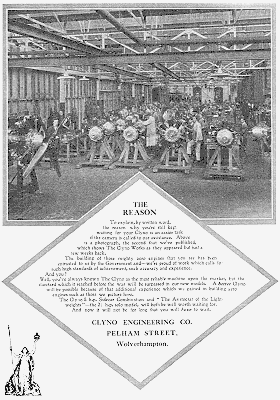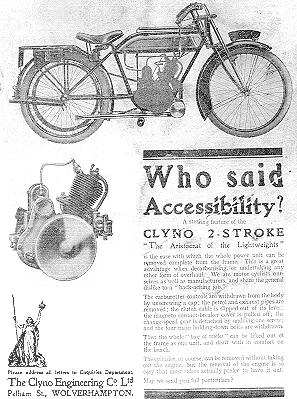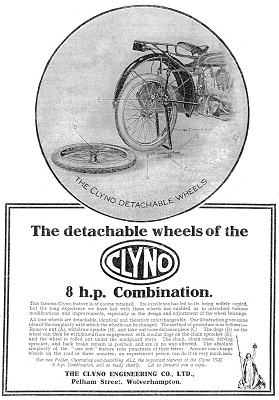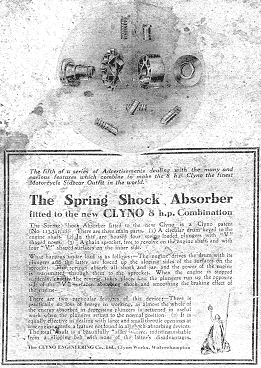Clyno Motorcycle
Adverts
The following adverts appeared in 1919 and 1920.
Unfortunately much of the text is quite small and so is unreadable in
the small photographs. Because of this we have included a transcript.

From the Chambers of Commerce Joint
Monthly Journal, published in 1920. |
Many motorcyclists desire a machine with which
there will be "no extras". Our Model de Luxe will be found to
satisfy this demand in every respect. Everything the rider can
want is included in the price. The full specification will be
sent on application, but here are a few words relative to its
electrical equipment.
This consists of a "Mag-dynamo" in place of the usual magneto.
The two are carried in one housing, but are electrically
independent. A flaw in either does not effect the other. The
dynamo charges an accumulator carried under the seat of the
sidecar. The lamps are supplied from this and consequently, the
light is steady at all speeds. The headlamp has a "dimming"
attachment for use in towns; the tail light is adapted for use
also as an inspection lamp; and the side lamp is so placed that
it gives the driver all the assistance he needs, and yet is
available for the passenger when wanting to look at a map or
watch. An electric horn is fitted to the upper front sidecar
connection, and is operated by a button on the left handlebar,
the current being supplied by the accumulator for the lamps. |
|
The Reason
To explain in written word, the reason why you're still kept
waiting for your Clyno is an easier task if the camera is called
to our assistance. The photograph, the second that we’ve
published, which shows the Clyno works as they appeared but just
a few weeks back. The building of those mighty aero engines that
you see has been entrusted to us by the Government and we’re
proud of work which calls for such high standards of
achievement, such accuracy and experience. And you? Well, you’ve
always known The Clyno as the most reliable machine upon the
market, but the standard which it reached before the war will be
surpassed in our new models. A better Clyno will be possible
because of the additional experience which we have gained in
building new aero engines such as those we picture here. The
Clyno 8h.p. Sidecar Combination and "The Aristocrat of the
Lightweights" – the 2.5h.p. solo model, will both be well worth
waiting for. And now it will not be for long that you will have
to wait. |

An advertisement from 'The Motor Cycle"
magazine that was published on 4th September, 1919. |

An advertisement from 'The Motor Cycle"
magazine that was published on 8th April, 1920. |
Who said Accessibility?
A sterling feature of the
Clyno 2 stroke
"The Aristocrat of the lightweights".
Is the ease with which the whole power unit can be removed
complete from the frame. This is a great advantage when
decarbonising, or undertaking any other form of overhaul. We are
motorcyclists ourselves as well as manufacturers, and share the
general dislike to a "back-aching job". The carburettor controls
are withdrawn from the body by unscrewing a cap; the petrol and
exhaust pipes are removed; the clutch cable is slipped out of
its lever; the magneto contact breaker cover is pulled off; the
change-speed gear is detached by undoing one screw; and the four
main holding-down bolts are withdrawn. Then the whole bag of
tricks can be lifted out of the frame as one unit, and dealt
with in comfort on the bench. The cylinder, of course, can be
removed without taking out the engine, but the removal of the
engine is so easy that most riders actually prefer to have it
out. |
| This famous Clyno feature is of course retained.
Its excellence has led to its being widely copied, but the long
experience we have had with these wheels has enabled us to
introduce various modifications and improvements, especially in
the design and adjustment of wheel bearings. All four wheels are
detachable, identical and therefore interchangeable. Our
illustration gives some idea of the simplicity with which the
wheels can be changed. The method of procedure is as follows:-
Remove nut (A), withdraw spindle (B), and take out loose
distance piece (C). The dogs (D) on the wheel can then be
withdrawn from engagement with similar dogs on the chain
sprocket (E), and the wheel is rolled out under the mudguard
stays. The chain, chain cases, driving sprocket, and the back
brake remain in position and are in no way affected.
The absolute simplicity of the ‘one nut’ feature robs
punctures of their terror. Anyone can change wheels in three
minutes; an experienced person can do it in very much less. |

An advertisement from 'The Motor Cycle"
magazine that was published on 1st April, 1920. |

An advertisement from 'Motor Cycling"
magazine that was published on 28th January, 1920. |
The Spring Shock Absorber fitted to the new
Clyno 8h.p. Combination.
The spring shock absorber fitted to the new Clyno is a Clyno
patent (No. 113341/18). There are three main parts:
1. A circular drum keyed to the engine shaft.
2. In this are housed four spring-loaded plungers with
"V" shaped noses.
3. A chain sprocket, free to revolve on the engine
shaft, and with four ‘V’ shaped surfaces on
the
inner side.
What happens under load is as follows: The engine drives the
drum with its plungers and the latter are forced up the sloping
sides of the surfaces on the sprocket. The springs absorb all
shock and jar, and the power of the engine is transmitted
through them to the sprocket. When the engine is stopped
suddenly, exactly the reverse takes place, the plungers run up
the opposite side of the ‘V’ surfaces absorbing the shock and
smoothing the braking effect of the engine. |
There are two particular features of this device. There is
practically no loss of energy in working, as almost the whole of the
energy absorbed in depressing plungers is returned in useful work when
the plungers return to the normal position. It is equally effective in
dealing with large and small throttle openings at low engine speeds, a
feature not found in all shock absorbing devices. The total result is a
beautifully ‘silky’ drive, indistinguishable from a slipping belt, with
none of the latter’s disadvantages.

|
| Return to
Clyno Motorcycles |
|







